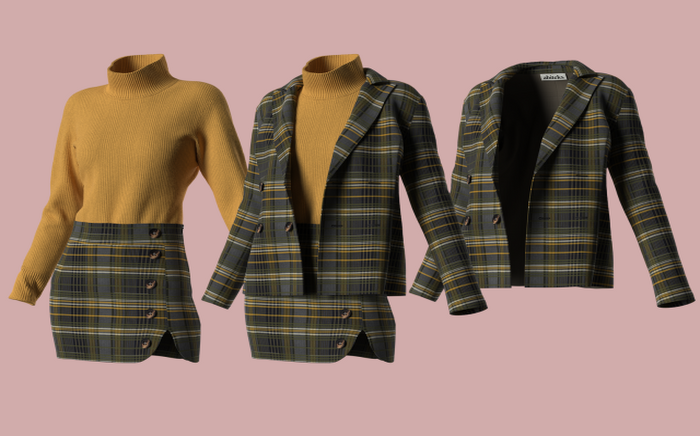The future is upon us. Following up on the automotive and architecture industries, the 3D design revolution has finally hit the fashion industry. And it seems this will only grow in popularity as the pandemic has had consumers and all industries questioning the harm we have inflicted on the Earth. We are at a stage where we can clearly see the effects our habits have had on the world, and we’re leaning towards finding more sustainable production methods for our businesses.
Although 3D prototyping may seem like a very minor change in a given business model, its positive effects truly shine through in the end. It not only helps us reduce the time we spent on making samples, but it’s also cost-efficient, and most importantly, allows us to cut down on unnecessary material usage and expenditure. The reduction of material usage and waste comes to the fore as a valuable asset for textile companies in a time where fashion is the second biggest polluting industry in the world. According to research conducted by McKinsey and Company, 60% of textiles are either incinerated or thrown away, ending up in landfills every year. If we consider the fact that although companies are trying to use more sustainable materials, we are still falling short in producing bio-degradable products, processes like incineration and decomposition in landfills only serve to pollute our air, water sources, and land further. Therefore 3D design and prototyping’s contributions to overall global sustainability cannot be ignored on a large scale. It’s not only eco-friendly though, as it cuts down on time wasted on producing prototypes and allows for improvement in lead times. When we take all of this into account, we can safely say that 3D design and prototyping have helped us achieve cost and time efficiency while allowing us to reach greater goals in sustainability and that it currently is and will be a valuable asset for textile companies in the future.
Another interesting use for 3D design is the budding virtual clothing industry, where custom made 3D clothes are sold virtually, sometimes as NFT’s or special items, and their usage can manifest in many different ways, including digital looks to be used in editorials, advertisements, or special items that could be won, bought or sold within video games. An interesting example would be the 2019 case where The Fabricant and Cartlings collaborated on the world’s first digital-only blockchain dress. The dress was used for editorial purposes only and sold for $9500, spawning similar concepts by different brands and paving the way for digital-only clothing brands like Tribute, Hanifa and online stores specializing in digital garments, like DRESSX.
3D prototyping does not only decrease a brand’s carbon footprint and open new doors of commerce within the fashion industry, it’s also proven to be a very helpful tool for designers. Unlike 2D design tools, 3D design programs allow designers to completely visualize a photo-realistic version of their work with all its details. 3D design programs also allow designers to make instant modifications to their work, without waiting for samples and fitting sessions. They can come very close to perfecting an outfit without the need for any prototypes before mass production, winning them time, cutting down on material costs, and reducing the lag in communication with their clients. Though 3D design hasn’t only aided corporations, it has also been a life-saver for freelancers, allowing them to venture out into the competitive design world without funds and showcase their creativity without limits. Through pattern exporting features, small fashion houses may also use these programs to create true-to-size clothing patterns within these programs without having to invest in pricey industrial pattern-making software. Since the arrival of 3D design into the fashion world, many creatives in the industry have found a practical outlet for their creativity and have been able to attract clients easier than ever. In a parallel effort, corporate brands and fashion houses are seeking out creatives with knowledge in 3D design software, as buyers, editors and creative directors are more interested in seeing photo-realistic samples than they are in seeing 2D artwork. 3D modeling software has also provided advantages in sizing solutions, with most 3D design software having size editable avatars. Jami Dunbar, the vice president of Under Armour’s apparel and accessories development department has stated “We’ve been able to make a much better product, with improved sizing, because the standardization involved really facilitates next-level accuracy. We’ve also been able to move faster and increase speed-to-market to remain competitive.”
The improvements in creative freedom, practicality, and sustainability that have been provided by the rise of 3D garment prototyping software are unquestionable. We can only imagine the upcoming advancements that will be made to further carry fashion into a digitilized realm, and the unlimited possibilities that may arise from this.
1. https://www.universityoffashion.com/blog/3d-revolution-part-3/
2. https://www.thefabricant.com/blog/tag/digital+fashion
3. https://thenextcartel.com/discover/digital-clothing-nft-fashion-business
4. https://scandinavianmind.com/news/6-brands-that-are-leading-the-way-for-virtual-fashion
5. https://alvanon.com/its-a-mindset-change-for-the-industry-fashion-brands-embrace-3d-design-tech/

 Back to Blog
Back to Blog











